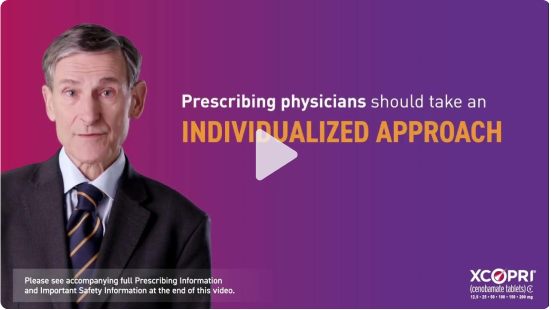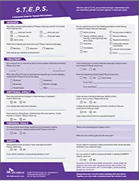Resources
Access real-world insights, XCOPRI patient stories, and downloadable tools to help your
patients and practice.
Access real-world insights, XCOPRI patient stories, and downloadable tools to help your
patients and practice.
Expert insights
Hear from your peers who have switched on XCOPRI—and are seeing meaningful results.

A chance to reach zero
In this powerful case study video, Pavel Klein, MB BChir, FAAN, FAES, discusses one patient’s journey with XCOPRI. Dr. Klein also covers his decision making in adding XCOPRI to the patient’s treatment regimen as adjunctive therapy, as well as his considerations regarding dosage adjustments.

The XCOPRI impact
Lawrence Seiden, MD, discusses one patient’s journey with XCOPRI in this compelling case study video. He discusses the path of a patient he’s been treating for over 12 years, and how, with XCOPRI, his patient went from having one seizure every 4 to 6 weeks—to almost zero.

Trust in efficacy
Michael Smith, MD, speaks to his growing trust in the efficacy of XCOPRI—and why his patients appreciate getting to monotherapy after often having been on many medications in their lifetime.

The possibility of zero seizures
Pavel Klein, MB BChir, FAAN, FAES, discusses the impact of XCOPRI on his patients whose lives have been taken over by seizures.
Real XCOPRI patient stories
See how XCOPRI is helping light the way forward for adult patients with seizures.


I want to let people know there is life after being diagnosed with epilepsy.”
Laura first started having nocturnal seizures at 57 years old. After diagnosis, she was forced into early retirement and feared epilepsy would prevent her from the vibrant social life she loved.
Now on XCOPRI, Laura is getting back to what matters most: her family, sports games, and rock and roll.


Don’t be afraid to ask. Don’t be afraid to try a different medication because XCOPRI thankfully worked for me.”
After an accident led to his epilepsy diagnosis in his mid-30s, Shannon struggled with embarrassment—especially when seizures happened at work or in front of his children.
With XCOPRI, Shannon has reclaimed his independence. He is back to his job as an airport terminal superintendent and enjoying cherished date nights with his daughters.


With those reductions, I feel like I’m in charge of my life again. Don’t ever settle for anything less than you deserve.”
Koral started having seizures in high school and spent years undiagnosed, battling multiple seizures a day while trying to keep up a normal teenage life.
Since starting XCOPRI, her seizure frequency has dramatically decreased. Today, Koral is back in college and continuing to pursue her passion as a teacher for children with autism.
Learn more about access and support available to help your patients get started on treatment.
Downloadable PDF resources
Our clinical resources and patient support tools are designed to help you make informed decisions, every step of the way.
Switching On XCOPRI Flashcard
This resource highlights important information about prescribing XCOPRI, how to titrate, and drug load reduction.

Getting Patients Started on XCOPRI Guide
Designed to assist healthcare professional office staff in initiating patients on XCOPRI, this resource provides comprehensive guidance on XCOPRI cost and coverage, prescribing information, and insights into the extensive support programs for both office staff and patients.

Patient Brochure
This brochure helps your patients understand what to expect from treatment. It includes information on how to take XCOPRI, potential side effects, and a patient-friendly version of the data from the clinical trials.

S.T.E.P.S. Discussion Guide
Standing for Seizures, Treatments, Emotional Impact, Personal Goals, and Safety, this discussion guide was designed to help foster a stronger relationship between patients and their care teams, and help those affected by epilepsy reach their goals.
The guide is based on a national survey that compiled responses from 400 adult patients, 201 caregivers, and 258 healthcare providers to help better understand the current state of epilepsy in the United States.

Next Steps With XCOPRI Brochure
This patient brochure helps new patients understand what to expect when starting XCOPRI, including guidance on filling their XCOPRI prescription, copay information, support programs, potential side effects, and patient testimonials.

Frequently asked questions
Explore answers to common questions about XCOPRI.
The International League Against Epilepsy considers a person to have epilepsy if they meet any of the following conditions1:
- At least 2 unprovoked (or reflex) seizures occurring greater than 24 hours apart
- Diagnosis of an epilepsy syndrome
- One unprovoked (or reflex) seizure and a probability of further seizures similar to the general recurrence risk (at least 60%) after 2 unprovoked seizures, occurring over the next 10 years
A seizure is an abnormal paroxysmal discharge of neurons.2 There are some things that can trigger seizures in patients with epilepsy. They include sleep deprivation, stress, fever, alcohol binging, use of recreational drugs, and use of some prescribed and/or over-the-counter medications.3
Seizures affect people differently, and there are several types of seizures. Seizures may come in 3 distinct phases, with a beginning, middle, and end. Some people experience an aura or other warning signs that a seizure is coming on, including dizziness, headache, nausea, or altered senses or emotions. During the middle of the seizure, some people lose consciousness or feel confused and/or experience tremors or can’t move at all, among many other possible symptoms. At the end, they may feel sleepy, scared, confused, or embarrassed, and/or they may have a headache, nausea, or weakness, to name a few symptoms.4
Most seizures last between 30 seconds and 2 minutes. However, depending on the type of seizure, it can be shorter or substantially longer. A seizure that lasts longer than 5 minutes is a medical emergency.5
Keep the person safe and call for medical help if the seizure continues for a prolonged period of time (longer than 5 minutes). After the seizure is over, stay with them or see them home safely.6
A partial-onset seizure, also known as a focal seizure, starts in one part of the brain and may stay there or may spread. This is different from a generalized seizure, which starts in both hemispheres of the brain at the same time.7
XCOPRI is indicated for the treatment of partial-onset seizures in adult patients, meaning 18 years and older. There are ongoing trials for the pediatric population, but safety and effectiveness in pediatric patients have not been established at this time.8
For additional information, please review the full Prescribing Information for XCOPRI.
Sample packs are available in 12.5 mg (weeks 1-2) and 25 mg (weeks 3-4).
To learn more about receiving samples of XCOPRI, connect with a sales representative. Please fill out a form here.
Patients saw significant reductions in overall seizure frequency during clinical trials, with as many as 1 in 5 patients achieving ZERO SEIZURES during the maintenance phase.8
The top 5 were levetiracetam, lamotrigine, lacosamide, carbamazepine/oxcarbazepine, and topiramate.8-10
Study 2 had a 6-week titration phase and a 12-week maintenance phase. The primary endpoint for each dose included all 18 weeks of treatment. Based on the titration schedule in that study, subjects in the 400 mg group did not reach their target dose of 400 mg until the beginning of the maintenance phase. However, there is a clear dose response (400 mg better than 200 mg) for subjects having a response of 75% to 100% during the maintenance phase.8
A statistical significance in the primary endpoint was demonstrated with 100 mg. Based on the current recommended starting dose and titration, 100 mg is reached at 6 weeks.8
For safety information related to XCOPRI, please see the XCOPRI full Prescribing Information.
XCOPRI should be used with caution, and dosage reduction may be considered in patients with mild to moderate (CLcr 30 to less than 90 mL/min) and severe (CLcr less than 30 mL/min) renal impairment. Use in patients with end-stage renal disease undergoing dialysis is not recommended.8
See the XCOPRI full Prescribing Information.
For patients with mild to moderate (5-9 points on the Child-Pugh assessment; Class A or B) hepatic impairment, the maximum recommended dosage is 200 mg once daily. XCOPRI is not recommended for use in patients with severe hepatic impairment.8
See the XCOPRI full Prescribing Information.
Familial Short QT syndrome is a life-threatening, inherited heart disease. In an article published in Heart Rhythm journal in 2018, which featured a review of papers published from 2000-2017, there were 220 patients identified with familial QT shortening.11
As per the XCOPRI full Prescribing Information, there is no recommendation to perform an electrocardiogram (EKG) prior to or during XCOPRI use.8
After the Food and Drug Administration (FDA) and Drug Enforcement Administration (DEA) review of the cenobamate New Drug Application (NDA), it was concluded that cenobamate has a relative abuse potential lower than substances in Schedule IV but greater than placebo and should be placed into Schedule V of the Controlled Substances Act.8
XCOPRI is a once-daily pill that is titrated in 2-week intervals and available in 6 tablet strengths.8
See the XCOPRI full Prescribing Information for complete information on how patients should take XCOPRI.
XCOPRI can be prescribed as monotherapy or adjunctive therapy.8
In clinical trials, the top 5 concomitant epilepsy medications used with XCOPRI were levetiracetam, lamotrigine, lacosamide, carbamazepine/oxcarbazepine, and topiramate.8-10
As per the XCOPRI full Prescribing Information, because of the potential for reduced efficacy of oral contraceptives, women should use additional or alternative nonhormonal birth control while taking XCOPRI.8
A list of drug interactions is provided in Section 7.1 of the XCOPRI full Prescribing Information. It is important to be aware of the potential emergence of side effects early in the XCOPRI titration with clobazam, phenytoin, and phenobarbital.8
For additional information, you may contact Medical Information by calling 1-866-657-5574, emailing [email protected], or visiting the Medical Information website by clicking here.
Learn more about prescribing XCOPRI as an adjunctive therapy.
XCOPRI can be purchased at any retail pharmacy.
Nine out of 10 Commercial, Medicare, and Medicaid patients have coverage.* If a prior authorization (PA) is required, ~90% of PAs are approved based solely on indication.*
Yes, we have a program called SK Life Science Navigator that may be able to provide financial support to patients meeting our Patient Assistance Program criteria. Patients can visit www.sklsinavigator.com or call 1-866-756-2844.
Eligible patients with commercial insurance can receive copay assistance at their pharmacy. If they are eligible, the copay assistance will automatically be applied at the pharmacy; patients do not need to enroll to be eligible.
Access
XCOPRI is widely accessible with low copays. Discover support available to get started
Learn about accessXCOPRI & epilepsy education
See educational offerings tailored for APPs and NPs, from CME/CE-accredited courses to interactive prescriber sessions led by featured experts
Start learning today